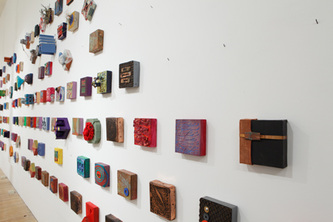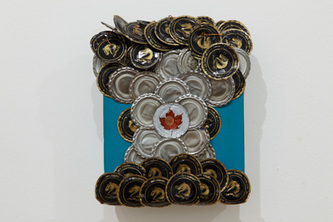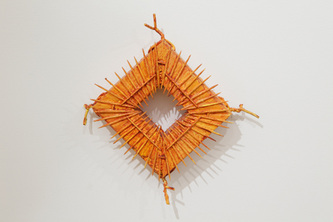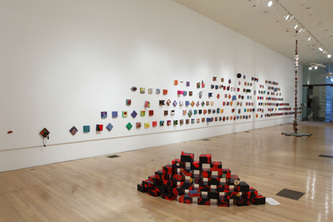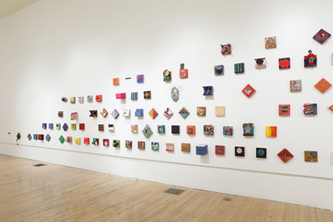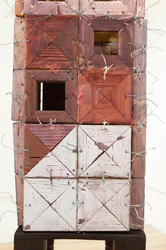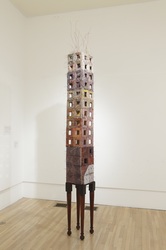Merz Installation: Designing within Limits
& The Art of Making Do
About this body of work....
Harrison's recurring MERZ installation projects are always inspired by the beginnings and endings of various renovation projects. When all funds are depleted the awareness of material limits: abundance and scarcity, kicks in. She chooses to work with only materials that she possesses.
This attempt to purchase few, if any, additional materials is partly Harrison's reaction to the growing tendency in art as well as other sectors to consume rather than create. Designing within constraints promotes inventive rather than consuming instincts to rise to the fore. The old adage "Necessity is the mother of invention" resonates. One need only enter the fair trade gift store "Just Creations" on Frankfurt Avenue in Louisville, Kentucky to see the truth of this statement. Craftsmen from all over the world have made the most amazing bags, coasters, picture frames, and other objects out of discarded paper and other materials.
The questions Harrison asks at the start and to which she keeps developing different answers are:
•What if each artist/designer was required to use a finite number of materials and to use and re-use all the refuse?
•If an artist had a truly self-sustaining and sustainable, "green" studio practice what would that look like?
•How can she use precious, used, stored, and discarded, throw away materials to continue with her on-going installation work?
•How do we as a community cut our dependence on land fills to remove our waste?
•Is the act of gathering, ordering and sorting an aesthetic value in and of itself?
•What is all this containing and storing for, and why do we have so much stuff that we need to save?
THE BEGINNING IN HER WORDS...
This project began the summer of 2008 when I first chopped boards, that were stored from a renovation project, into blocks upon which I began to draw and paint, and over which I hammered precious, etched and inked copper. As my limited resources were consumed I developed new strategies for creating the blocks. Next I concentrated on responding playfully and dynamically to using the discards and the waste from this on-going project to enable me to extend it. For instance, once all of the staples were used up, I began lashing wood together with wire, and once all of the wire was used up, I used the discarded wire sheathing as sculptural material. All the original boards have been consumed and to work with a block I must now create one. At one point I created a shoebox-sized sculpture using only tiny wedge shapes to design a tile pattern of sorts. I had to raid my own trash can to retrieve the discarded “waste” to create this work. The irony is that by using these very limited “waste” materials I have created some sculptures with seemingly infinite possibilities. “Spindle and Pattern” juxtaposes web-like, order with linear chaos. The wedges have nail holes speaking to lost, or latent potential or functionality and also relate this structure to the graph and structure of the wall configuration. The nails on the wall complement the holes of the wedges. This again hints at displacement and/ or belonging, and an order found in living within limits.
INSPIRATION
I am inspired by the work of Wols (Wolfgang Schulze), Paul Klee, and Kurt Schwitters, who coined the term "Merz." He found great pleasure in blurring the boundaries between ordinary objects and art, and “a desire to erase the opposition between the realm of art and the ordinariness of daily life.” I also pay tribute to the extreme resourcefulness of those who lived through World War I and II, the Great Depression, as well as modern day disasters. This installation features some of the illustrations of James Gordon Irving. His illustrations inspired me as a child and are significantly responsible for instilling in me a tremendous concern and respect for animals, self-sustaining ecosystems, and the natural world. I have discovered over the years that one's sense of identity and belonging may be challenged by the impact and consequences of physical displacement and re-location from place to place:
• What is it about material possessions and material goods beyond their essential functionality that holds our attention and comforts us?
•How do we hold on to our memories of people and things?
•Do our materials serve as prompts and cues and pathways to our remembering of important moments and as reminders of the love we have experienced. Are we defined by our things?
•Do our personal libraries, photo albums, letters, clothing, and other collections prop up are sense of self and who we are?
NEW OPPORTUNITIES
With Harrison's new renovation project at 428 East 6th St, New Albany, IN this on-going project is bound to begin a new chapter. A trash can full of lath and leftover wood from all the re-modeling projects is bound to inspire some new forms and structures part of this continuing body of work. Stay tuned as there is more to come....
Updated January 2015
Harrison's recurring MERZ installation projects are always inspired by the beginnings and endings of various renovation projects. When all funds are depleted the awareness of material limits: abundance and scarcity, kicks in. She chooses to work with only materials that she possesses.
This attempt to purchase few, if any, additional materials is partly Harrison's reaction to the growing tendency in art as well as other sectors to consume rather than create. Designing within constraints promotes inventive rather than consuming instincts to rise to the fore. The old adage "Necessity is the mother of invention" resonates. One need only enter the fair trade gift store "Just Creations" on Frankfurt Avenue in Louisville, Kentucky to see the truth of this statement. Craftsmen from all over the world have made the most amazing bags, coasters, picture frames, and other objects out of discarded paper and other materials.
The questions Harrison asks at the start and to which she keeps developing different answers are:
•What if each artist/designer was required to use a finite number of materials and to use and re-use all the refuse?
•If an artist had a truly self-sustaining and sustainable, "green" studio practice what would that look like?
•How can she use precious, used, stored, and discarded, throw away materials to continue with her on-going installation work?
•How do we as a community cut our dependence on land fills to remove our waste?
•Is the act of gathering, ordering and sorting an aesthetic value in and of itself?
•What is all this containing and storing for, and why do we have so much stuff that we need to save?
THE BEGINNING IN HER WORDS...
This project began the summer of 2008 when I first chopped boards, that were stored from a renovation project, into blocks upon which I began to draw and paint, and over which I hammered precious, etched and inked copper. As my limited resources were consumed I developed new strategies for creating the blocks. Next I concentrated on responding playfully and dynamically to using the discards and the waste from this on-going project to enable me to extend it. For instance, once all of the staples were used up, I began lashing wood together with wire, and once all of the wire was used up, I used the discarded wire sheathing as sculptural material. All the original boards have been consumed and to work with a block I must now create one. At one point I created a shoebox-sized sculpture using only tiny wedge shapes to design a tile pattern of sorts. I had to raid my own trash can to retrieve the discarded “waste” to create this work. The irony is that by using these very limited “waste” materials I have created some sculptures with seemingly infinite possibilities. “Spindle and Pattern” juxtaposes web-like, order with linear chaos. The wedges have nail holes speaking to lost, or latent potential or functionality and also relate this structure to the graph and structure of the wall configuration. The nails on the wall complement the holes of the wedges. This again hints at displacement and/ or belonging, and an order found in living within limits.
INSPIRATION
I am inspired by the work of Wols (Wolfgang Schulze), Paul Klee, and Kurt Schwitters, who coined the term "Merz." He found great pleasure in blurring the boundaries between ordinary objects and art, and “a desire to erase the opposition between the realm of art and the ordinariness of daily life.” I also pay tribute to the extreme resourcefulness of those who lived through World War I and II, the Great Depression, as well as modern day disasters. This installation features some of the illustrations of James Gordon Irving. His illustrations inspired me as a child and are significantly responsible for instilling in me a tremendous concern and respect for animals, self-sustaining ecosystems, and the natural world. I have discovered over the years that one's sense of identity and belonging may be challenged by the impact and consequences of physical displacement and re-location from place to place:
• What is it about material possessions and material goods beyond their essential functionality that holds our attention and comforts us?
•How do we hold on to our memories of people and things?
•Do our materials serve as prompts and cues and pathways to our remembering of important moments and as reminders of the love we have experienced. Are we defined by our things?
•Do our personal libraries, photo albums, letters, clothing, and other collections prop up are sense of self and who we are?
NEW OPPORTUNITIES
With Harrison's new renovation project at 428 East 6th St, New Albany, IN this on-going project is bound to begin a new chapter. A trash can full of lath and leftover wood from all the re-modeling projects is bound to inspire some new forms and structures part of this continuing body of work. Stay tuned as there is more to come....
Updated January 2015


